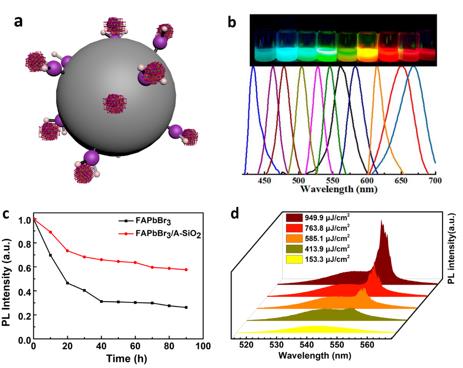Formamidinium (HC(NH2)+; FA) perovskite materials have great potential applications in nano-lasers owing to their remarkable optoelectronic properties of large absorption coefficients, high photoluminescence quantum yields as well as narrow band emissions. However, the hypersensitivity of halide perovskite materials under UV irradiation would lead to their rapid decomposition. Besides, the reported thresholds of perovskite random lasing are relatively high, which is ascribed to the low light scattering.
Recently, a research group from Shanghai Institute of Optics and Fine Mechanics, Chinese Academy of Sciences, in cooperation with Chongqing University, has made a new progress in photostability and random lasing performance of formamidinium lead halide perovskite quantum dots. The result was published in ADVANCED OPTICAL MATERIALS.
In this work, the researchers successfully anchored the FAPbX3 QDs onto the surfaces of the A-SiO2 spheres using a facile and valid synthetic strategy. Amazingly, they found that the FAPbBr3/A-SiO2 composites demonstrated excellent photostability after continuous illumination under UV lamps due to the effective suppression of the interactions and mutual contact between FAPbBr3 particles.
In addition, up-conversion random lasing with low lasing threshold (413.7μJ /cm2) and high-quality factors (1037) could be achieved from the FAPbBr3/A-SiO2 composites at room-temperature, which originated from the multiple random scattering of light and photon recycling provided by the silica spheres and the high gain characteristic of FAPbBr3 QDs.
This research would provide a new platform for applications of the FAPbBr3/A-SiO2 composites in integrated speckle-free imaging and perovskite lasers.
The work was supported by the Strategic Priority Research Program of the Chinese Academy of Sciences, International S&T Cooperation Program of China, CAS Interdisciplinary Innovation Team, and the National Natural Science Foundation.

The emission spectra and the high efficiency up-conversion random lasing. (Image by SIOM)
Article website:
https://doi.org/10.1002/adom.202000290
Contact:
Mr. CAO Yong
General Administrative Office
Shanghai Institute of Optics and Fine Mechanics, CAS
Email: caoyong@siom.ac.cn